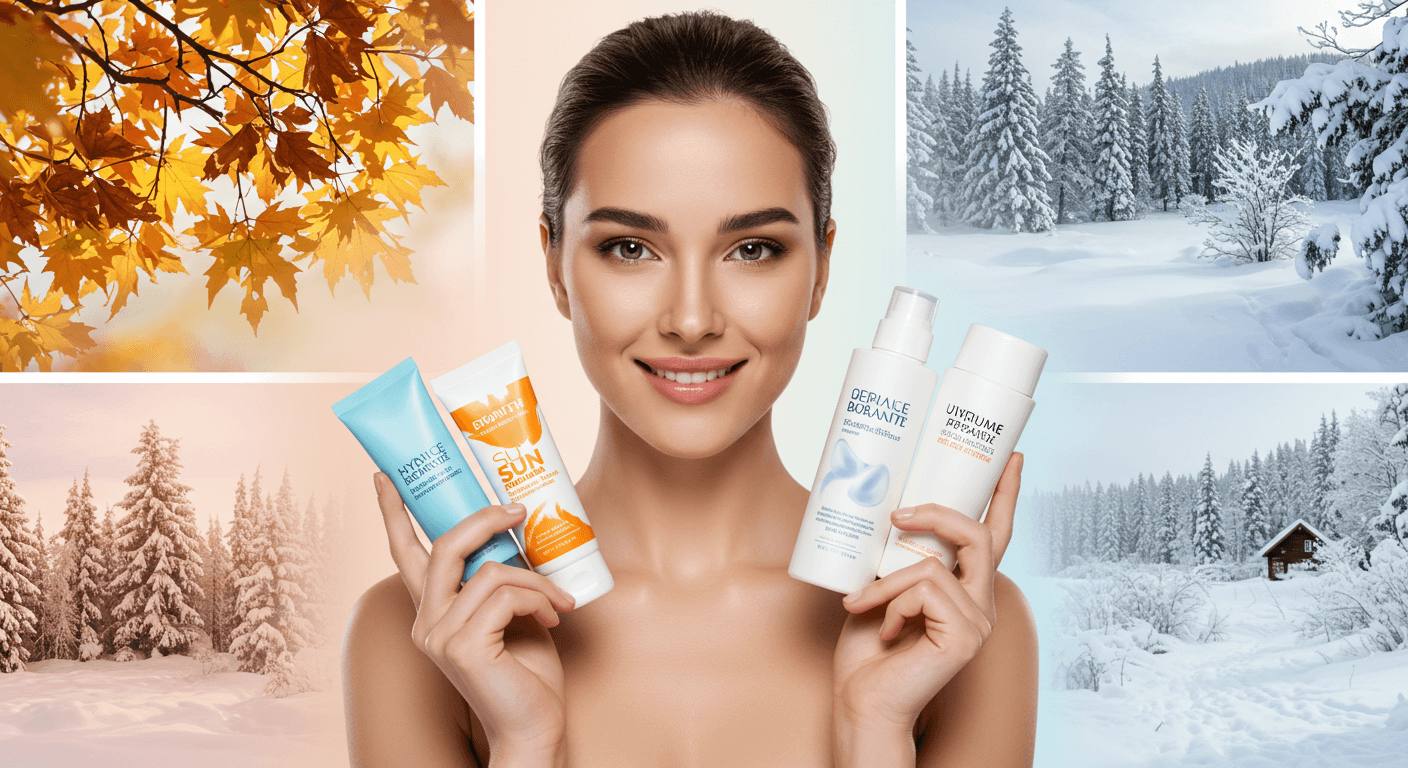Many people overlook the importance of adjusting their skincare routine as the seasons shift. Your skin faces unique challenges throughout the year, from harsh winter winds to the intense summer sun. By understanding how temperature and humidity affect your skin, you can prevent issues like dryness, breakouts, and irritation. This guide will help you make effective changes to keep your skin healthy and glowing, no matter the season.
Table of Contents
Key Takeaways: Adapting Your Skincare for Changing Seasons.
- Hydration: Increase your use of moisturizers during colder months to combat dryness.
- SPF Protection: Even in winter, apply sunscreen daily to protect against UV damage.
- Gentle Cleansing: Switch to a milder cleanser in winter to avoid stripping imperative oils from your skin.
- Exfoliation: Adjust your exfoliation routine based on seasonal changes; less frequently in summer, more in winter.
- Targeted Treatments: Tailor your skincare products, such as serums and treatments, to address seasonal skin concerns (e.g., acne in humid months, dryness in cold months).
Understanding Skin Types
While adapting your skincare routine for seasonal changes, it’s imperative to first understand your skin type. Identifying your skin type will help you select the most suitable products and practices that will nourish and protect your skin throughout the year. Here’s a quick overview of the common skin types:
| Normal | Balanced, neither too oily nor dry |
| Oily | Greasy, enlarged pores, acne-prone |
| Dry | Flaky, rough texture, may feel tight |
| Combination | Mixture of oily and dry areas |
| Sensitive | Reactive, prone to redness and irritation |

Identifying Your Skin Type
Skin types can vary significantly from one person to another, impacting how your skin reacts to products and environmental changes. You can begin identifying your skin type by observing how your skin behaves under different conditions and after various skincare routines. Notably, it can help to assess your skin’s attributes by evaluating the following characteristics:
- Feel of the skin after cleansing (tightness or oiliness)
- Presence of pores (size and visibility)
- Frequency of breakouts (acne or blemishes)
- Conditions like redness or irritation
- Overall hydration levels (dryness or flakiness)
By pinpointing your skin type, you gain valuable insight into the specific needs of your skin, allowing you to choose products that effectively maintain and enhance its health. This understanding lays the groundwork for adjusting your skincare routine as seasons shift.
Skin Type Variations by Season
Assuming your skin will behave the same year-round can lead to unexpected challenges. Various factors such as changes in temperature, humidity, and sun exposure can greatly influence the way your skin feels and performs. For instance, in the winter, your skin might feel drier and may require a richer moisturizer, while during the summer months, it might produce excess oil and need lightweight formulations.
Another point to consider is that your skin type can appear to fluctuate with the seasons. During fall and winter, it is common for your skin to become drier due to lower humidity levels, prompting adjustments to hydration products. Conversely, spring and summer may lead to increased oiliness, calling for lighter, oil-free options to keep breakouts at bay. Being aware of these variations will help you tailor your routine efficiently.
Perceiving these changes, you can maintain your skin’s balance and overall health, ensuring you are always equipped to combat the effects of seasonal transitions.
Key Factors Influencing Seasonal Changes
Clearly, as the seasons change, so do the demands of your skin. Understanding the key factors that influence these changes is necessary for tailoring your skincare routine effectively. The most significant factors to consider include:
- Weather
- Climate
- Humidity
- Indoor vs. Outdoor Conditions
- Skin Type
Knowing these elements will help you navigate through the transition from one season to another, ensuring that your skin remains healthy and vibrant no matter the conditions.

Weather and Climate
You may find that changes in weather and climate directly affect your skin’s health and appearance. In warmer months, increased humidity can lead to excess oil and breakouts, while cold, dry winter air can strip moisture from the skin, leading to dryness and irritation. Pay attention to the temperature fluctuations—these can shift your hydration needs, necessitating lighter products in the summer and richer formulations in the winter.
Adjusting your skincare according to weather patterns not only maintains the moisture balance but also helps in preventing skin conditions that can be exacerbated by harsh climates. Emphasizing the importance of these factors will set the groundwork for understanding how best to care for your skin throughout the year.
Indoor vs. Outdoor Conditions
Even the difference between indoor and outdoor conditions plays a significant role in how your skin reacts to the changing seasons. Indoors, the *heating* in winter can dry out the air and lead to a lack of moisture in your skin, while in summer, air conditioning can do the same. Outside, UV exposure during summer can accelerate skin damage, while winter winds can further dehydrate your skin. It’s important to consider how both environments affect your skin’s overall health and appearance.
Weather changes can significantly impact your skin’s hydration and resilience. Indoor heating can strip moisture, causing skin to become flaky and irritated, while air conditioning can lead to similar concerns in summer. Conversely, outdoor elements like wind and sunshine necessitate increased protection and hydration. Understanding these indoor vs. outdoor dynamics will allow you to adapt your skincare routine effectively to create a protective barrier against the elements.
Seasonal Skincare Tips
Not taking the time to adapt your skincare routine to the changing seasons can lead to issues such as dryness, irritation, or breakouts. With the different environmental factors at play throughout the year, you should consider adjusting your hydration, sun protection, and exfoliation techniques. Here are some simple tips to help you tailor your skincare regimen:
- Evaluate your moisturizers: Thicker creams may work well in winter, while lighter gels are better suited for summer.
- Switch to a more hydrating cleanser as temperatures drop.
- Increase your SPF protection during the sunnier months.
- Opt for gentle exfoliation during harsher weather to avoid damaging your skin.
- Don’t forget to hydrate from the inside out—drink plenty of water.
After making these adjustments, you’ll be better prepared to handle what each season throws your way. If you’re curious about how to adjust my skincare routine according to different seasons, seeking more personalized guidance could enhance your routine even further.

Spring and Summer Skincare
Even as the temperatures rise, it’s vital to keep your skin balanced and protected. During spring and summer, focus on lightweight formulas that provide hydration without feeling heavy. Consider incorporating a gel-based moisturizer or a light lotion that won’t clog your pores, which is especially important during hot and humid days. Furthermore, investing in a high-quality sunscreen is non-negotiable; choose a broad-spectrum option with at least SPF 30 to shield your skin from harmful UV rays.
Exfoliation also plays a significant role in preparing your skin for sun exposure. You might find chemical exfoliants gentle yet effective. However, be cautious not to over-exfoliate, as this can lead to increased sensitivity. To maintain glowing skin, include antioxidants in your routine, such as serums rich in vitamin C, which can help combat sun damage and keep your skin radiant.
Autumn and Winter Skincare
With cooler temperatures looming, it’s vital to shift your skincare approach to combat the effects of dryness and harsh weather. Consider switching to a thicker, more emollient moisturizer packed with ingredients like hyaluronic acid or ceramides. These ingredients will help lock in moisture and restore your skin’s natural barrier that might be compromised in the brisk air. Also, a humidifier in your living space can be a fantastic tool to maintain hydration levels in your skin while indoors, especially in environments heated for warmth.
Tips for your autumn and winter skincare routine include staying vigilant about your exfoliation. You may want to reduce the frequency to prevent irritation and sensitivity. Always look for products that have soothing and hydrating properties, such as aloe vera or oatmeal, to effectively calm your skin. Keeping your skin well-moisturized is vital to combat the dryness and potential flakiness that colder climates can cause. Additionally, don’t hesitate to reassess your sunscreen habits; even in winter, UV protection remains necessary to ward off damage.
Step-by-Step Seasonal Skincare Routines
Despite the beauty of changing seasons, they can pose unique challenges for your skin. Each season brings different environmental factors that can impact your skin’s health and appearance. Therefore, it’s vital to adapt your skincare routine accordingly to ensure your skin remains balanced and radiant throughout the year. The following table breaks down vital skincare routines for each season, so you can easily navigate your skincare needs.
Seasonal Skincare Routine Breakdown
| Season | Key Adjustments |
|---|---|
| Spring | Introduce lightweight hydrators and increase exfoliation |
| Summer | Opt for oil-free moisturizers and enhance SPF protection |
| Fall | Switch to creamier products to combat dryness |
| Winter | Layer occlusive agents and use richer moisturizers |

Morning Routine Adaptations
While morning skincare routines should focus on protection and hydration, adapting them according to the season can maximize your results. In spring and summer, consider incorporating lighter products, such as gel-based moisturizers and serums rich in antioxidants. This will help combat the effects of pollution and sun exposure while maintaining a fresh and dewy complexion. During fall and winter, however, prioritize heavier moisturizers and consider adding a nourishing facial oil to create an effective barrier against harsh environmental elements.
Additionally, don’t overlook the importance of SPF in your morning routine. In summer, use a high SPF sunscreen, and in spring and fall, choose products with sun protection to shield your skin. Staying consistent with your morning routine will not only prepare your skin for the day ahead but also create a strong foundation for your overall skin health during seasonal transitions.
Evening Routine Adjustments
One of the most important times to adjust your skincare routine is in the evening. As temperatures fluctuate between seasons, your skin’s need for hydration and repair will also change. In warmer months, consider using lighter formulations with exfoliating acids in the evenings to help rejuvenate your skin. In contrast, during the colder months, you might opt for richer creams and multi-layered moisturizing products to combat dryness and lock in moisture while you sleep.
Adaptations to your evening routine should also include a careful assessment of your skin’s condition. For example, if you’re experiencing dryness in winter, adding a hydrating serum before your moisturizer can provide an extra boost. Conversely, if your skin tends to be oily during the summer, you might want to skip heavier creams altogether and focus on lightweight, gel-based products. Tailoring your routine based on your skin’s seasonal needs will ensure you wake up with a radiant and balanced complexion.
Pros and Cons of Seasonal Skincare Changes
Many skincare enthusiasts find themselves adjusting their routines with the changing seasons. However, while these adjustments can be beneficial, they can also have some downsides. Understanding both the pros and cons of altering your skincare regime can help you make informed choices. Below is a breakdown of the advantages and disadvantages:
| Pros | Cons |
|---|---|
| Better hydration in winter | Potential for skin irritation |
| Protection from summer sun | Time-consuming to adjust products |
| Improved skin barrier functionality | Increased costs for new products |
| Targeted solutions for seasonal issues | Overwhelming choices of products |
| Maintaining a fresh glow year-round | Difficulty finding the right fit |

Benefits of Adapting Your Routine
An effective seasonal skincare routine can significantly enhance your skin’s overall health and radiance. By tailoring your products to general climate conditions—such as incorporating heavier creams in winter or lighter formulations in summer—you can achieve optimal hydration levels, address specific concerns like dryness or oiliness, and safeguard your skin against environmental stressors. These adjustments allow your skin to thrive in a way that simply sticking to a year-round regimen might not provide.
Moreover, maintaining a proactive approach to your skincare can foster a more dynamic and interesting self-care experience. When you engage with the changing seasons through your skincare routine, it enables you to experiment with various textures and ingredients, keeping your regimen exciting while also delivering targeted benefits. This versatility not only helps you reconnect with your skin but also inspires you to be more mindful of its varying needs as the temperatures fluctuate.
Potential Drawbacks to Consider
For some people, altering your skincare for the seasons has its challenges that can be difficult to navigate. You may find that your skin takes time to adjust to new products, potentially leading to temporary issues like breakouts or sensitivity. Additionally, frequently switching products can create uncertainty regarding what works best for your skin type, resulting in frustration and even financial strain from buying numerous options that may not be effective.
Benefits of constantly reassessing your routine can lead to confusion, especially if you find that your skin does not respond well to new formulations. The process of trial and error can be costly and may leave you feeling less confident about your choices. Staying vigilant and informed about your skin’s reactions to seasonal changes is imperative for cultivating a successful skincare regimen that genuinely supports your needs.
Additional Tips for Skincare Adaptation
Now that you have a basic understanding of how to adapt your skincare routine with the seasons, consider these additional tips to enhance your regimen. It’s imperative to stay attuned to how your skin reacts to seasonal changes, as this will help you refine your approach over time. Regularly check in with your skin’s needs and focus on these key areas:
- Prioritize hydration—layer products for added moisture.
- Examine your sunscreen—opt for a broad-spectrum formula year-round.
- Utilize exfoliation to prevent buildup during dry seasons.
- Be mindful of allergens in your environment and adjust accordingly.
Assume that by following these strategies, you will better support your skin’s health, keeping it vibrant and resilient regardless of the season.

Incorporating New Products
For optimal skin health, seamlessly incorporating new products into your routine can make a world of difference. Spring and summer often call for lighter formulations, while fall and winter might require richer textures. Start slowly by introducing one new product at a time to identify how your skin reacts. Ensure you select products with active ingredients that target your specific skin concerns and are suitable for the season.
Additionally, look for seasonal ingredients that can amplify benefits. In autumn, think of adding moisturizers with nourishing botanicals or oils that aid in combating dryness, while summer may benefit from light, gel-based formulas that prevent excess oil and shine. This strategic approach will help you build a regimen that adapts fluidly as the seasons change.
Lifestyle Changes for Better Skin
Better skin often stems from an integrated approach that goes beyond topical treatments. Consider how daily habits impact your complexion. Hydrating adequately, eating a balanced diet rich in antioxidants, and prioritizing quality sleep can all contribute significantly to your skin’s health. When seasons shift, your body’s needs may change, so adjust your lifestyle practices accordingly to support skin vitality.
Skincare extends well beyond products—it incorporates your entire lifestyle. Factors such as maintaining consistent hydration levels and ensuring that your diet includes necessary vitamins and minerals can enhance your skin’s resilience. Pay attention to your daily routines, incorporating regular exercise to promote circulation and limit stress, which can lead to breakouts. Make it a habit to reassess your lifestyle and incorporate changes that empower your skin to thrive in every season.
Summing Up
On the whole, adapting your skincare routine to align with the changing seasons is an important step in maintaining healthy, radiant skin throughout the year. As temperatures shift, your skin’s needs will vary. By recognizing these fluctuations, you can tailor your products and regimen, ensuring that your skin remains hydrated in winter and protected in summer. This proactive approach not only addresses immediate concerns like dryness or excess oil but also helps to prevent long-term skin issues caused by environmental factors.
Incorporating seasonal adjustments into your skincare routine empowers you to respond to your skin’s unique requirements. Whether it’s switching to a lighter moisturizer during hotter months or adding nourishing oils to your regimen in the colder season, developing a flexible strategy allows you to maintain balance. Ultimately, prioritizing your skin’s specific needs throughout the year will help you achieve a healthy complexion that is prepared for any weather condition.
FAQ:
Q: How does my skin change with the seasons?
A: Your skin can react differently to the changing weather conditions. In cold, dry months, skin often becomes drier and may require more hydration. Conversely, during hot and humid weather, skin may become oilier and more prone to breakouts. It is beneficial to observe these changes and adjust your skincare routine accordingly.
Q: What specific products should I change for winter skincare?
A: In winter, switching to a more emollient-rich moisturizer can be very effective. Look for products containing ingredients like hyaluronic acid, glycerin, or ceramides, as they help retain moisture. Additionally, consider using a thicker cream at night and using a gentle exfoliating product to remove dry, flaky skin while being cautious not to over-exfoliate.
Q: How can I adjust my skincare for summer?
A: During summer months, lightweight, oil-free moisturizers are often best. Incorporating a gel-based moisturizer can provide hydration without feeling heavy. Also, use sunscreen daily, as UV exposure is more intense. Look for non-comedogenic formulas to avoid clogging pores and consider adding a gentle exfoliant to help with excess oil and prevent breakouts.
Q: Are there any seasonal ingredients I should consider incorporating into my routine?
A: Yes! In winter, ingredients such as shea butter and lanolin can be beneficial for added moisture. In the summer, look for products with antioxidants like vitamin C or green tea to combat oxidative stress from sun exposure. Also, ingredients like aloe vera and cucumber can provide cooling effects during hotter months.
Q: How often should I reevaluate my skincare routine as the seasons change?
A: It’s advisable to evaluate your skincare routine at the start of each season. As the climate changes, your skin’s needs will also evolve, and making adjustments to your products, such as moisturizers and sunscreen, will help maintain skin health. Keeping a closer watch on your skin’s behavior can also guide further tweaks to your regimen throughout the season.



























0 Comments